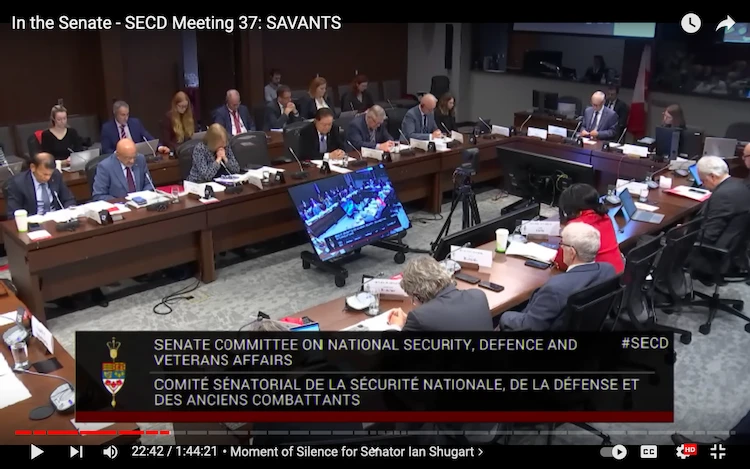In the Senate – SECD Meeting 3 SAVANTS
Introduction: The recent Senate SECD meeting on Bill C-21, streamed on the Canadian Sports Shooting Federation YouTube channel, offers a plethora of insights and recommendations from esteemed witnesses. These insights, while wide-ranging, consistently stress the importance of a structural overhaul of Canada’s public safety and security approach. Highlighting the Witnesses’ Solutions:
- Throughout the meeting, the witnesses placed emphasis on several key areas that demand immediate attention:
- Enhanced Border Capabilities: Strengthening our borders will not only prevent illegal trade and potential threats but also solidify our national security.
- Enhanced Police Capabilities: Our law enforcement needs both modern resources and advanced training to handle contemporary challenges effectively.
- Enhanced Youth Intervention Capabilities: By investing in our youth, especially those at risk, we can deter crime at its inception.
- Enhanced Domestic Shelter Capabilities: Offering protection and services to those fleeing domestic abuse or hardship is not just a moral imperative; it’s crucial for societal stability. Enhanced Intelligence and Data Analytics Capabilities: In the digital age, data-driven decisions can preemptively address potential threats and streamline our public safety approach.
Challenging the Status Quo: The SECD meeting revealed a stark disparity between the government’s current trajectory with Bill C-21 (May 2020 OIC) and the real-world solutions the witnesses propose. It’s vital to question the efficacy of legislation that primarily focuses on imposing restrictions on groups not associated with crime, especially in economic downturns where scarce capital of Canada is almost impossible to gain access to. Such an approach, devoid of building necessary public safety infrastructure, could inadvertently suppress cultural conservative movements or sports movements, leading to an erosion of the very fabric of our society.
Rethinking Investments: A recurring theme in the testimonies was the need to redirect investments from restrictive legislative endeavours pertaining to public safety, towards front-line solutions and front-line capabilities. Instead of spending scarce financial resources to destroy the property of members of the population statistically proven to not cause crime, a focus on laws that may not resonate with ground realities, the government should prioritize resilience-building measures, hiring workers and robots not destroying people’s assets in the home. These measures, and measures proposed by the witnesses, will not only enhance public safety, but also uplift Canada’s socio-economic landscape due to the increased trust in Canada as a reliable country, both legislatively and in terms of intelligent infrastructure deployment. (good leadership) SECD’s Potential Historical Stand: One cannot overstate the significance of agencies like SECD in shaping a nation’s destiny. In these tumultuous times, SECD has a golden opportunity to make a historical stand. By advocating for policies rooted in the practical solutions proposed by the witnesses, they can send a powerful message about their commitment to genuine public welfare over evolving bureaucratic compliances expecting more of police or of responsible firearms owners, sports shooters, hunters and associated business elements.
Conclusion: As echoed by the witnesses, true public safety is an amalgamation of proactive measures and robust infrastructure. It’s high time Canada transitions from a restrictive mindset to one of empowerment, resilience, front line capability, growth, emergency planning and preparedness. By investing in our border officers recruitment, border technology drone adoption and scanning device adoption, police recruitment, youth, shelters, mental health, the professional development of Statistics Canada in terms of data science adoption, and improved intelligence systems capabilities (it’s been proven at every single in the government the lack of data and analytics for evidence-based decision making), we can pave the way for a safer, more prosperous future. Let this analysis serve as a clarion call for SECD and the broader government to usher in this much-needed change.
Postscript: As Skills Gap Trainer, we deeply appreciate the thoroughness and commitment displayed by all participants in the meeting. The collective wisdom from this meeting can serve as a beacon for Canada, illuminating the path to a brighter tomorrow. – SGT Team
(PS: CCFR Community and International Sports Shooters of Canada (Olympic Shooters), don’t leave the other sports shooting disciplines to not be included with the elite athletes in any legislation, protect them at sports shooting disciplines and access of all firearms to all disciplines, at all costs).
YouTube Link: https://youtu.be/EDr_-Oi6XW4?si=E6DVCnorkBIgf6Zs
“Take Action! https://scrapc21.ca
Related books and resources:
“More Guns, Less Crime: Understanding Crime and Gun Control Laws“ by John R. Lott Jr. This book examines the effects of various gun control laws in the United States and their impact on crime rates, relevant to the debate surrounding Bill C-21.
“The Canadian Firearms Program: A Comprehensive Guide“ by the Royal Canadian Mounted Police. This official guide provides a detailed overview of Canada’s current firearms program, laws, and regulations, serving as a baseline for understanding proposed changes.
“Armed and Considered Dangerous: A Survey of Felons and Their Firearms“ by James D. Wright and Peter H. Rossi. This study offers insights into the relationship between criminal activity and firearms, contributing to a nuanced discussion on gun control legislation.
“Guns and Violence: The English Experience” by Joyce Lee Malcolm. Malcolm’s examination of gun control and violence in England provides a comparative perspective that can enrich the debate on Canadian firearms legislation.
“Shooting to Kill?: Policing, Firearms, and Armed Response” by Peter Squires and Peter Kennison. This book looks at the use of firearms by police and the implications for public safety and policy, relevant to discussions about enhancing police capabilities.
“Gun Control in the Third Reich: Disarming the Jews and ‘Enemies of the State'” by Stephen P. Halbrook. Halbrook’s historical analysis provides a cautionary tale about the potential consequences of disarmament and gun control laws.
“Ricochet: Confessions of a Gun Lobbyist” by Richard Feldman. Feldman provides an insider’s view on the politics of gun control and the firearms industry, offering a perspective that might parallel some discussions in Canadian contexts.
“Canadian Criminal Justice: A Primer (5th Edition)” by Curt T. Griffiths. This textbook offers a comprehensive overview of the Canadian criminal justice system, with relevance to discussions on public safety and legislative change.
“The Politics of Gun Control” by Robert J. Spitzer. Spitzer’s analysis of gun control politics in the United States can provide comparative insights into the Canadian situation and legislative processes.
To see our Donate Page, click https://skillsgaptrainer.com/donate
To see our Instagram Channel, click https://www.instagram.com/skillsgaptrainer/
To see some of our Udemy Courses, click SGT Udemy Page
To see our YouTube Channel, click https://www.youtube.com/@skillsgaptrainer


